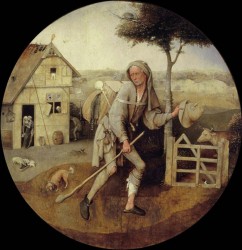
Sudeck 1931
“Hieronymus Bosch” (Elisabeth Sudeck) 1931
[in: Elisabeth Sudeck, Bettlerdarstellungen vom Ende des XV. Jahrhunderts bis zu Rembrandt. Studien zur deutschen Kunstgeschichte – Heft 279, J.H. Ed. Heits, Strassbourg, 1931, pp. 12-20]
[Also mentioned in Gibson 1983: 63 (D95)]
Sudeck deals with three works by Bosch in which beggars are depicted: a painting with two blind men who fall into a ditch, only preserved through a sixteenth-century print by Petrus a Merica (= Peter van der Heyden), the so-called Prodigal Son tondo (Rotterdam) and a drawing with crippled beggars (Vienna, Albertina).
The drawing
Apparently with Bosch the physical handicap of the crippled is at the same time a sign of a certain degree of mental aberration. Bosch interprets ‘being crippled’ in a moralising sense. The drawing also contains a certain kind of humour that can be linked to the comical function of crippled persons in late medieval plays (in a note Sudeck claims that as members of the Brotherhood of Our Lady Bosch, his father and one of his uncles participated in the performance of mystery plays). Whereas the humour in these plays seems somewhat indecent and rough to our modern perception, Bosch’s humour leans towards anxiety and horror because he mixes the bizarre with realism. For Bosch the crippled beggars (the drawing shows 31 of them) provide material for his experiments with the fantastic.
The so-called Prodigal Son
The main figure of the Rotterdam tondo is a Landstreicher (vagabond, tramp). The painting probably depicts a proverb with moralising character. Sudeck has borrowed these two ideas from Baldass. With Baldass she rejects the interpretation of the main figure as the Prodigal Son. The tondo is less allegorical than other works by Bosch, but it has a strong genre character. The universal ethical content is not expressed through symbols but through the psychological individual treatment of the main figure, who expresses doubt and hope for salvation. Primordial with Bosch is not the individualizing renaissance form, but the ethical, didactic message. The painting does not express social concern, but an abstract idea. In a note Sudeck also says some brief things about the closed wings of the Haywain triptych. According to her the main figure here is a fleeing peasant hinting at social injustice (the great lords have everything and the poor have nothing).
The print with the blind men
This print has been interpreted as the depiction of a dutch proverb and also as a biblical reference to Luke 6. Sudeck thinks that this biblical text was so appealing to Bosch’s contemporaries that it became proverbial. Although she does not mention it explicitly, it is because of this context that Sudeck supposes that the Rotterdam tondo also depicts a proverb.
Conclusion
The form and message of Bosch’s depictions of beggars strongly differ from each other. These depictions bear witness to both the medieval, allegorical-mystical aspect of his art and the more modern, renaissance one (the latter viewing the beggar as an object of pragmatic and medical research).
[explicit]